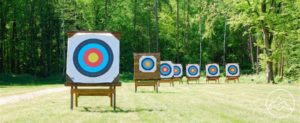Archery, a sport with a rich history dating back thousands of years, has stood the test of time and continues to captivate enthusiasts around the world. From its origins as a hunting technique to its current status as a popular sport, archery has evolved and adapted, offering both physical and mental benefits to its practitioners. The art of shooting arrows with a bow requires skill, precision, and focus, making it a holistic activity that engages both the body and the mind. Moreover, engaging in archery has been associated with numerous health benefits, such as the development of strong muscles, improved coordination, and a reduction in anxiety and depression. With various types of bows and styles of archery to explore, archery presents a timeless and rewarding pursuit for individuals of all ages and abilities. Whether one seeks the thrill of competition or the tranquility of target practice, archery offers a unique and fulfilling experience.
Key Takeaways
- Archery is a sport that has evolved from hunting to a recreational activity.
- It requires both physical and mental strength and offers various health benefits.
- There are different types of bows and styles of archery, each with its own advantages.
- Learning proper form and seeking guidance from experienced archers are crucial for success in archery.
What is it?
Archery is a sport that involves using a bow to shoot arrows, and it has a rich history dating back to around 20,000 BC, evolving from hunting to become a popular recreational activity and competitive sport. The importance of proper form in archery cannot be overstated. It is crucial for consistent accuracy and injury prevention. Good form involves maintaining a stable stance, aligning the body correctly, and executing proper release and follow-through techniques. Archery also offers numerous benefits for mental health. The focus required to hit targets and the meditative aspect of the sport can help reduce anxiety and depression. Additionally, the physical and mental strength required in archery can build confidence and improve overall well-being. Whether pursued as a hobby or a competitive sport, archery provides a timeless activity that combines physical exercise with mental discipline.
Types and Equipment
There are a variety of different types of bows, including the longbow, recurve, compound, and crossbow, each with their own unique characteristics and advantages. The longbow is a traditional style bow that is simple in design and requires a lot of strength to use effectively. The recurve bow is a more modern design that features curved limbs, which provide more power and speed to the arrow. The compound bow is a technologically advanced bow that uses pulleys and cables to increase the power and accuracy of the shot. Lastly, the crossbow is a horizontal bow that is mounted on a stock and shot using a trigger mechanism. When choosing archery equipment, it is important to consider factors such as skill level, intended use, and personal preference. It is recommended to consult with experienced archers or professionals to ensure the right equipment is chosen for optimal performance.
Getting Started
To begin your journey in the world of archery, it is essential to first familiarize yourself with the basic equipment required for this ancient sport. Choosing the right bow is crucial, as it will greatly impact your archery experience. There are four main types of bows to choose from: longbow, recurve, compound, and crossbow. Each type has its own characteristics and advantages, so it is important to consider your personal preferences and goals before making a decision. After selecting your bow, the next step is to find a local archery range. This will provide you with a safe and controlled environment to practice and improve your skills. It is recommended to seek guidance from experienced archers at the range, as they can provide valuable tips and advice to help you get started on the right foot.
Frequently Asked Questions
What are the different types of archery competitions and how do they differ from each other?
There are several types of archery competitions, each with its own unique characteristics. Target archery is the most common and is the only type allowed in the Olympics. It involves shooting at stationary targets from specific distances. Field archery simulates hunting situations and is done outdoors at various distances. 3D archery involves shooting at three-dimensional animal targets to simulate real-life hunting experiences. Bowhunting is archery for hunting live animals, requiring state tags and ethical shooting skills. These competitions differ in their settings, targets, and objectives.
What are some common mistakes to avoid when starting out in archery?
When starting out in archery, there are common mistakes to avoid to ensure proper technique and maximize success. One of the key mistakes is incorrect form, which can impact accuracy and consistency. It is important to learn and practice the correct shooting stance, grip, and body alignment. Another common mistake is an improper grip on the bow, which can lead to inconsistent shots. Proper guidance from experienced archers is essential to avoid these mistakes and establish a strong foundation in archery.
Are there any age restrictions or physical requirements for participating in archery?
Age restrictions and physical requirements for participating in archery can vary depending on the specific context and purpose. In general, archery is a sport that can be enjoyed by people of all ages and physical abilities. Many archery programs and clubs offer classes and programs for children as young as 8 years old, while others have no age restrictions. As for physical requirements, archery is a sport that can be adapted to accommodate individuals with disabilities or physical limitations. However, it is always advisable to consult with a qualified instructor or coach to ensure proper technique and safety.
How can I find local archery clubs or ranges in my area?
To find local archery clubs or ranges in your area, there are several methods you can use. First, you can conduct an online search using keywords such as “archery clubs near me” or “archery ranges in [your location].” This will provide you with a list of potential options. Additionally, you can reach out to local sporting goods stores or community centers, as they may have information on nearby archery facilities. Lastly, consider joining online archery communities or forums, where members often share information about local clubs and ranges.
What are some tips for properly maintaining and caring for archery equipment?
Proper maintenance of archery equipment is crucial for optimal performance and longevity. Here are some equipment care tips for archery. Firstly, regularly inspect your bow for any signs of damage or wear, such as cracks or frayed strings. Secondly, clean your equipment after each use, removing dirt, debris, and moisture to prevent rust and corrosion. Thirdly, store your equipment in a cool, dry place to avoid exposure to extreme temperatures or humidity. Lastly, regularly replace worn-out components, such as arrows or bowstrings, to ensure consistent accuracy and safety.
Conclusion
In conclusion, archery is a timeless sport that offers numerous health benefits. Its rich history and evolution from a hunting technique to a popular sport demonstrate its enduring appeal. Engaging in archery not only builds strong muscles and improves coordination but also helps reduce anxiety and depression. The different types of bows and styles of archery provide options for individuals with varying preferences and goals. By learning the rules, practicing good form, and seeking guidance from experienced archers, one can embark on a rewarding journey in the world of archery.












